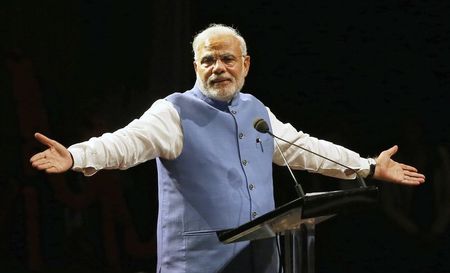By Frank Jack Daniel and Sanjeev Miglani
NEW DELHI (Reuters) - India's Prime Minister Narendra Modi has a long list of pro-growth measures to implement over the next four months, but time may have already run out to breathe enough life into the economy to meet the tough 2014/15 fiscal deficit target.
Modi's election victory in May unleashed a rush of money from foreign portfolios betting the reformist prime minister would drive a quick recovery. That has yet to materialise, with both factory utilisation and capital spending low.
Parliament convenes on Monday for a month-long session in which the government is confident of passing legislation to allow more foreign investment in the insurance industry, despite hostile opposition parties. Other bills, including labour and land reform, will face stiff opposition.
After the session ends on Dec. 23, focus will turn to Finance Minister Arun Jaitley's second budget, due in February and seen as a chance for the government to address criticism it has not moved quickly or boldly enough on the economy.
"They are quite aware of the urgency, that this cannot just be an incremental budget," said author and commentator Gurcharan Das, a former CEO of Proctor and Gamble India. "They think of this of this as a transformative budget."
Jaitley set a tough fiscal deficit target of 4.1 percent of GDP in his maiden budget. Slack tax revenues and the challenge of raising a record $9.5 billion (6.07 billion pound) target from asset sales could force him to cut spending, risking a fragile economic recovery.
"India looks set to miss its fiscal target this year, even in the optimistic case that the government fully delivers on its plans to sell stakes in state-owned companies," Capital Economics' Shilan Shah said in a research note.
Shah said missing the target would not be such a bad thing, given that looser fiscal policy could help the economic revival.
GDP LOOMING
After moving slowly on economic policy, including the asset sales, in his first six months in office, Modi has now picked up the pace.
Last week the government announced it would auction dozens of coalfields by February as well as allow foreign firms to mine coal for the first time. Asset sales should begin with the sale of a stake in oil firm ONGC in early December.
Even if such moves are implemented straight away, one senior government source said, their impact will take months to be felt.
GDP data due on Nov. 28 will give a clearer picture of how the economy fared in the quarter to September, but with factories running nearly 30 percent below capacity, few expect a big rebound from the worst slowdown since the 1980s.
One finance ministry source said on Friday that 2014/15 economic growth was likely to be at the lower end of the 5.4-5.9 percent forecast factored into the current budget, while tax receipts may fall short by 700 billion rupees ($11 billion).
Opposition parties have not so far not agreed to support even the relatively uncontroversial insurance bill, or a constitutional amendment needed for a goods and services tax, raising concerns of a log jam in the upper house of parliament, where Modi's party is in minority.
Recognizing that the investment and economic recovery is "yet to materialise", and that tax receipts are well below budget estimates, the government has turned to excise measures such as a fuel tax to claw back revenue.
One proposal under discussion is to place a duty on imports of crude oil, three government sources said. The proposal is opposed by India's oil refiners.

Other revenues could come from planned auctions of mobile telephone and FM radio spectrum early next year.
(Additional reporting by Manoj Kumar and Nidhi Verma; Editing by Douglas Busvine and Simon Cameron-Moore)